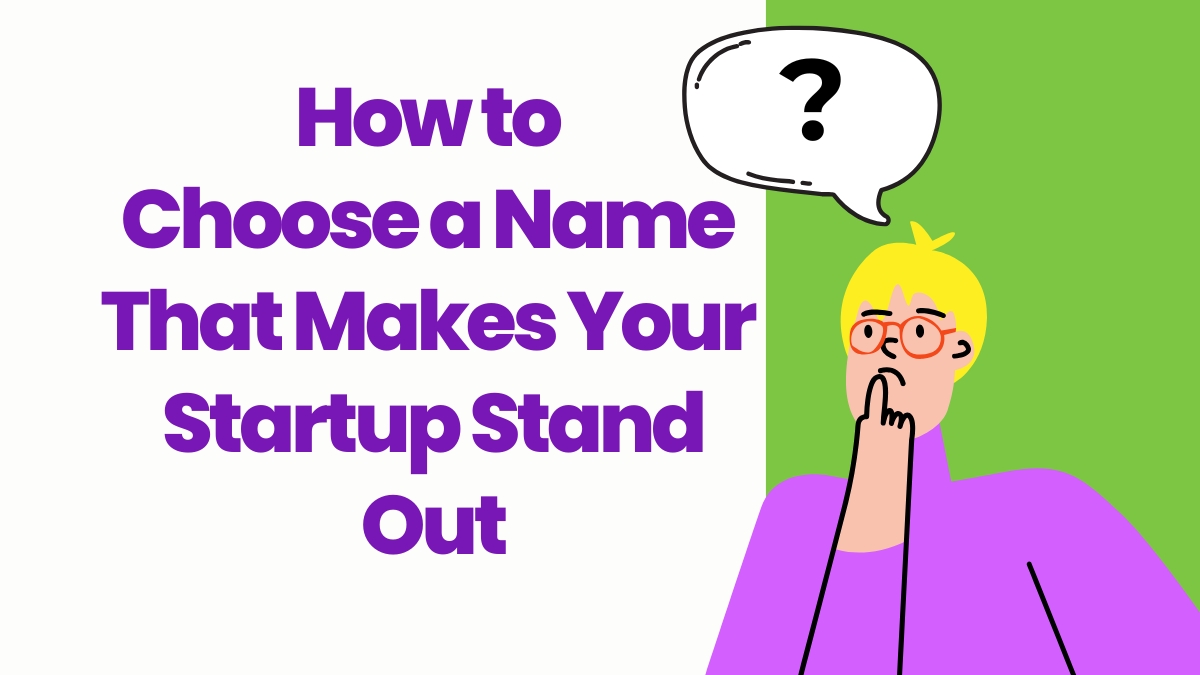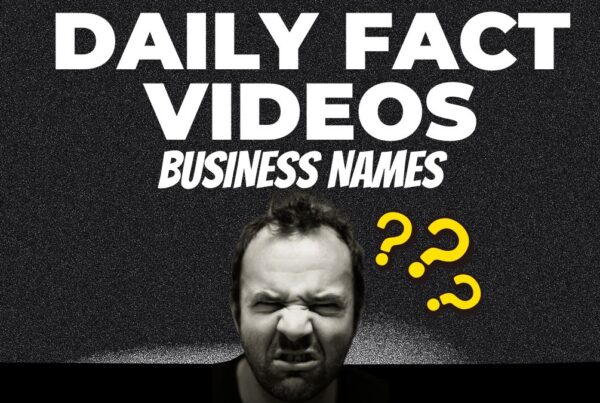Your Startup Name Is Your First Pitch
Before users try your product, investors see your pitch, or anyone visits your website, they see your name. Regardless of whether you’re launching a scrappy solo tool or a venture-capital-supported rocketship, the name matters more than most founders admit.
The name of your startup serves as your initial impression, a shorthand for your brand, and an amplifier of your growth—or it can act as a bottleneck.
In this guide, we’ll break down:
- Why naming is harder (and more important) than ever
- Common mistakes founders make when choosing a name
- A framework to create a name that actually sticks
- Real-world examples and inspiration
- What makes a name “collab-worthy” in today’s ecosystem
Let’s dig in.
Why Startup Naming Feels Broken in 2025
Each month, more than a million new businesses are started—and the majority of quality .com domain names are already registered. With the addition of AI-generated name tools, social handle squatting, and early-stage copycats, the process of naming your startup can feel like house hunting in a bidding war.
However, this is actually a piece of good news.
It is the limitations that compel creativity; startups with unique names attract attention, receive inbound collaborations, and experience smoother brand development.
Naming in 2025 Is a Game of:
- Clarity vs. Curiosity: You need to be clear about what you do, but still spark intrigue.
- Availability vs. Memorability: You want it to be short, findable, and easy to say—without looking like you pulled random Scrabble tiles.
- Speed vs. Strategy: You can’t let naming slow down your launch, but you shouldn’t wing it either.
The Most Common Naming Mistakes (That Still Happen All the Time)
A weak name won’t kill your startup—but it can absolutely slow you down. Here are the traps that trip up most early founders:
1. Choosing Names That Are Too Generic
Examples: “QuickTech,” “SmartTools,” “CloudX”
These names disappear in a sea of sameness. They don’t give investors or users a hook to remember you by—and forget about standing out in search results.
2. Over-Complicating It
Founders sometimes lean too hard into abstract, overly clever, or compound names:
- “Synergexis”
- “BluMentis”
- “KwikRyzt”
Sure, they might sound startup-y—but they’re hard to spell, hard to say, and almost impossible to remember without context.
3. Ignoring Domain & Social Handle Availability
You might fall in love with a name… only to find out the .com is owned, the TikTok handle is parked, and someone else is already running ads with that exact name.
Tip: Check domain + social availability before you get emotionally attached.
4. Forgetting Future Flexibility
Naming your crypto wallet app “CoinBuddy” might limit you when you later expand into a full fintech suite.
A Simple Framework for Naming a Startup That Pops
When a name clicks, it does a few things at once:
- It says something about your mission or space
- It sounds good out loud
- It sticks in someone’s head after one read
Here’s a framework to test or brainstorm your next startup name.
1. Use the “One-Second Gut Check”
Say the name out loud to someone. Ask:
“What do you think this is?”
If their guess is within 1–2 categories of your real offering—you’re in the right zone.
2. Run the SMILE Test
(from Alexandra Watkins, author of Hello, My Name is Awesome):
- Suggestive of what you do
- Memorable
- Imagery-provoking
- Likes to be said
- Extendable for brand use
Avoid names that make people:
- Spell it out every time
- Confuse it with competitors
- Rely on inside jokes or puns
3. Anchor to One Emotional Angle
Pick an emotion you want associated with your brand:
- Trust (e.g., “Candid,” “Basecamp”)
- Playfulness (e.g., “Figma,” “Framer”)
- Speed (e.g., “Zapier,” “Sling”)
Then ask yourself: does this name amplify that feeling?
Real Startup Names That Work — and Why
A one-word .com domain or a $250,000 branding agency is not necessary for you. You need something that matches your vibe, your market, and the modern-day internet.
Let’s break down a few names that actually work in 2025 and why:
- Notion
A clean, minimalist name that sparks ideas and creativity. While it started with note-taking, it’s broad enough to scale beyond.
- Memorable
- Evocative
- Brand-flexible
- Beehiiv
A clever spin on “beehive” that instantly communicates community, collaboration, and energy — perfect for a newsletter platform.
- Unique spelling
- Visual metaphor
- Instantly brandable
- Copy.ai
Direct and SEO-friendly, this name says exactly what it is: AI-powered copywriting. No guesswork needed.
- Keyword-rich
- Immediate clarity
- Scalable scope
- Loom
A soft, one-word name linked to storytelling and sharing. It’s simple, verbal, and calm.
- Emotional resonance
- Strong verb potential (“I’ll Loom it”)
- No fluff
When (and Why) to Rename Your Startup
Changing your name isn’t a failure — it’s part of the process. Plenty of now-famous companies had cringey first names:
- Slack was originally called Tiny Speck
- Instagram was Burbn
- Google started as Backrub
So how do you know when it’s time to rebrand?
You Might Need a Rename If:
- Your name no longer fits what you actually do
- Customers consistently confuse it or mispronounce it
- You’re expanding to a new audience and the old name feels limiting
- You’re hitting growth walls (ads, SEO, PR) because your name is too generic
Rebranding doesn’t have to be dramatic. You can even phase it in quietly — especially with a product-led growth strategy.
Naming Trends to Watch in 2025
Naming trends shift fast — and if you can ride one without being a clone, you’ll stand out. Here’s what’s hot in 2025:
1. One-Word Names With Hidden Depth
We’re seeing more brands embrace single-word names that hint at a bigger story. Think:
- “Luma” (light, clarity)
- “Canny” (smart, intuitive)
- “Pace” (momentum)
These names are flexible and easy to build around — especially with a solid brand identity.
2. .AI, .SO, .IO Extensions Still Have Juice
While .com is still king, alternative domains are now widely accepted — especially in B2B or AI-first niches.
Example:
- Orbit.so feels smoother than “OrbitApp.com”
- Formly.ai instantly signals it’s AI-powered
Pro tip: Make sure your name + domain combo passes the radio test (people can say it and know how to spell it).
3. “Operator” or “Builder” Energy
With more founders becoming creators and indie builders, we’re seeing names that reflect identity and motion:
- Makerly
- FoundrLoop
- Buildify
- HustlStack
These are great if you’re targeting solopreneurs, operators, or early-stage builders.
Case Study: How a Name Sparked Viral Growth
Let’s look at a real-world example of how a strong name played a major role in growth — even before the product hit full scale.
Case: “Lemonade” (Insurance Tech)
Lemonade stepped into the boring, dusty realm of insurance with a name that was playful, fresh, and seemed almost overly casual. And that’s the point.
What Worked:
- The name stood out instantly in a sea of legacy brands like “State Farm” or “Liberty Mutual.”
- It was easy to remember, spell, and say, even in different languages.
- It made people curious: “What is Lemonade? That doesn’t sound like insurance.”
Result: massive early press, viral product buzz, and a cult following — all built before people even tested the app.
This is what a non-obvious name with clear contrast can do in a traditional space.
Naming Tools & Resources to Speed Things Up
If you want to skip the blank page and get straight to usable name ideas, here’s a quick stack of tools and resources:
Free Tools:
- NameLix – AI-generated names by keyword + vibe
- Wordoid – Invents brandable, semi-random names
- BustAName – Finds available domain combos
- Lean Domain Search – Good for .com matching
- Thesaurus.com – Still underrated for lateral thinking
Paid But Worth It:
- Squadhelp – Get hundreds of crowd-voted name ideas
- BrandBucket – Curated names with domain included
- Dot-o-mator – Pairs name fragments + checks domain availability
How to Name with SEO, Collabs, and Press in Mind
Your name doesn’t just affect your brand — it shapes how people find you, share you, and want to work with you.
Here’s how to make your name collab-friendly:
1. Make It Easy to Include in Content
If your name is catchy and relevant, it’s more likely to be:
- Listed in “top tools” roundups
- Used as an anchor for link insertions
- Mentioned in newsletter shoutouts
Example: “We tested five AI tools like Jasper and Synthic. Here’s what happened…”
2. Give People a Hook
A good name is a talking point. Something a podcast host or guest post writer can play with.
Example:
“We use BlinkStorm to automate shortform edits — the name alone made us curious.”
3. Use the Name in Your CTA
Whether you’re pitching collabs or cross-posting, use your name as a lead-in:
“We’re building ThreadPop — a faceless content engine for Reddit-to-TikTok workflows. Want to swap links or collab?”
What to Do After You Pick a Name
Naming isn’t just about picking — it’s about activating. Here’s what to do next:
1. Lock Down Key Assets
- Secure the domain
- Register socials (even if you won’t use them yet)
- Create a simple logo or brandmark
- Set up a landing page, even if it’s basic
2. Google It Like an Investor
Search the name:
- Any existing companies using it?
- Trademark conflicts?
- Is it tied to any weird results (news, slang, urban dictionary)?
3. Start Using It Everywhere
Brand recognition happens fast if you’re consistent:
- In email sign-offs
- In Twitter/X bios
- As a hashtag
- In subreddits and Slack communities
Get your name in circulation before you even launch.
How Investors & Advisors React to Names
Let’s be honest: VCs do care about names. Even if your product is great, a name that resembles that of a B2B toothbrush brand will raise questions.
What Great Names Signal to Investors:
- You understand the market
- You know how to stand out
- You’re thinking long-term
- You care about brand and positioning — not just code
Some early-stage decks even include a short note like:
“Yes, we own the .com”
“Name tested well in founder/creator communities”
“Built to flex into other verticals”
These tiny details add confidence to your pitch.
Questions to Ask Before You Lock It In
Ask yourself (or your team) these five questions before making the name official:
- If someone heard this on a podcast, could they spell it?
- Does it still make sense if we pivot in 12 months?
- Can we explain why we picked it in 1 sentence?
- Would we want this printed on a T-shirt, hat, or hoodie?
- Does it sound like a real company — or a weekend project?
Final Thoughts: Your Name Isn’t Everything, But It’s a Force Multiplier
A perfect name isn’t necessary — just a workable one that helps you advance to the next level.
In an enormous collection of forgettable apps, tools, and SaaS clones, having a name that resonates can be your most underestimated advantage. It creates opportunities. It earns mentions. It creates an atmosphere.
Whether you’re coming up with ideas for your first project or reconsidering a name that’s holding you back, use this guide to cut through the distractions and arrive at something that truly works.
But if naming still feels harder than it should be, you’re not imagining it. Check out our next piece, Why Naming in Tech is Getting Harder, to explore the hidden pressures, pitfalls, and patterns shaping today’s most critical branding decisions.




